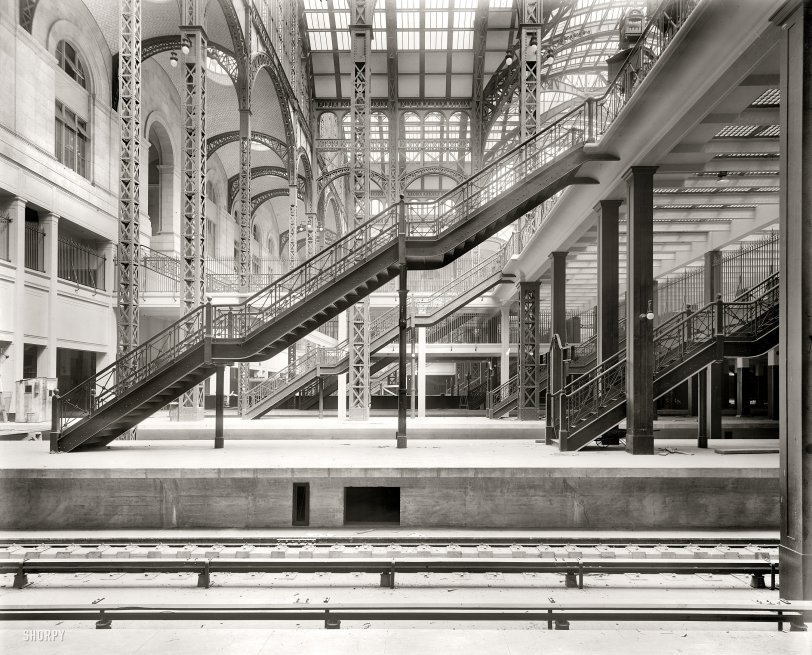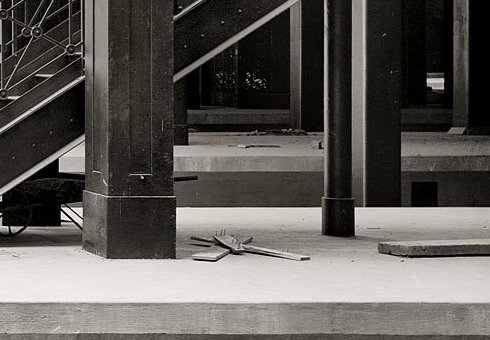


Framed or unframed, desk size to sofa size, printed by us in Arizona and Alabama since 2007. Explore now.
Shorpy is funded by you. Patreon contributors get an ad-free experience.
Learn more.

- Freeze Frame
- Texas Flyer wanted
- Just a Year Too Soon
- WWII -- Replacing men with women at the railroad crossing.
- Yes, Icing
- You kids drive me nuts!
- NOT An Easy Job
- I wonder
- Just add window boxes
- Icing Platform?
- Indiana Harbor Belt abides
- Freezing haze
- Corrections (for those who care)
- C&NW at Nelson
- Fallen Flags
- A dangerous job made worse
- Water Stop
- Passenger trains have right of way over freights?
- Coal
- Never ceases to amaze me.
- Still chuggin' (in model form)
- Great shot
- Westerly Breeze
- For the men, a trapeze
- Tickled
- Sense of loneliness ...
- 2 cents
- Charm City
- What an Outrage
- Brighton Park
Print Emporium
Penn Station: 1910

New York ca. 1910. "Pennsylvania Station. Track level, main and exit concourses, stair entrance." 8x10 inch glass negative, Detroit Publishing Co. View full size.
No title needed.
Imagine anymore the vision for having a building whose primary purpose would be to create a life experience for those passing through, and incidentally to also serve as a train station! We live cheaper lives now in many ways.
All the whining in the world
All the whining in the world about how unsightly, grimy, or whatever Penn Station was in its declining years (all of which could have been dealt with by apportioning for its upkeep a fraction of the money that went into real-estate thugs' pockets in the transactions that led to its demise) can't obscure the fact that a soaring, beautiful monument to the aspirations of man was replaced with a squalid, stunted, cheap and uncomfortable monument to greed and hubris.
The Sistine Chapel is reputed to be just awfully expensive to keep clean; why not spray acousti-tile over it and be done with the burden?
When you stepped out of your train onto that platform, the astonishing and unexpected vastness of the space around you was a perfect metaphor for the possibilities of your future in America's greatest city. As I suppose the current incarnation is as well, in its own way, in this Age of the Bankster.
I consider myself lucky to have there, grime, panhandlers, dirt, and all.
Form vs. Function
A note to all the "Monday Morning Preservationists" -- would you prefer to drive to West New Jersey to see the Knicks? Rangers? Concerts? The dog show? A decrepit museum was replaced by a useful, functioning building. If you want to see what Penn Station would look like today, go across the Hudson to Hoboken and take a look at the Hoboken Ferry station. Without money to maintain its turn of the century glory, the ferry station has turned into a depressing mausoleum of days gone by.
Maybe not in its prime
But when I first saw it in 1958 it blew my 12-year-old mind. A fitting entry portal for the "Standard Railroad of the World."
The 11:31 to Babylon
I see this same view every night when I catch the 11:31 to Babylon. Except now there is a ceiling roughly 15 feet overhead, complete with various pipes and other assorted infrastructure that make the experience of travel so rewarding.
Up and Down
Ramps were not needed since anyone in need could use elevators from the concourse towards the left that would take them down to track level.
Though 99% of the architecture is lost, those same staircases and elevators are still in use today.
Joe from LI, NY
So Bright
It's amazing how much effort was put into letting natural light into this space. From the windows and skylights to the glass block floors they did everything they could to maximize it. Unfortunately, with dirt and grime accumulating over time, it no doubt got more and more dark and foreboding. It's not something most would notice as it happened gradually, but that along with the inevitable dust and other detritus gathering on all that open steelwork I can only imagine how disgusting the place must have been in its twilight years. The lack of proper maintenance and utter disdain for classical architecture that prevailed in the mid 20th century certainly didn't help.
Many historic treasures have been restored to an amazing condition that few knew existed. Images like this show just how breathtaking some of these great old spaces that we see today as grungy and dark can be if they're properly restored.
Underlying fundamentals
Penn Station's success as a functioning train station is confirmed by the fact that nearly all the below grade facilities - tracks, platforms, and even some stairways - are still in use today. The universal regret over the loss of the superb public spaces above grade is reflected in the most recent proposal for the site, Moynihan Station, which aims to recreate these spaces right across the street inside the the shell of the old Post Office Building, another design from the office of McKim, Mead and White.
Practice Run
Though the station appears to have not yet opened for use there is a DD1 transfer locomotive a few platforms in the background. These locomotives used outside third rail and had a small pantograph to collect power from an overhead catenary.
"It was a crime to tear it down!"
This is a moldy bit of received wisdom that's become tedious by constant repetition. Penn Station may have been pleasant to look at in 1910, but by 1960 it was a decrepit eyesore that was a complete bust as a functioning train station. If even half of the Monday-morning preservationists who bemoan its fate had been willing to put some money where their mouths were, it might still be around.
Penn's legacy
As many probably know, Penn Station was owned by the spiraling-towards-bankruptcy Pennsylvania Railroad. The Pennsy couldn't afford to keep this giant station operating when the air rights over the tracks were so lucrative (the space over the tracks now Madison Square Garden).
Its destruction lead to the modern preservation movement. Many historic structures have been saved due to this building loss, and subsequent awareness of the value of significant buildings.
A beautiful 20th century cathedral.
I looked into Wiki to see when it was built and, as I thought, it was brand new in 1910 when the picture was taken.
Based on the exterior photos I have seen, the current Pennsylvania Station doesn't hold a candle to this one.
Booooard!
Would be said soon, but not quite yet. The debris and construction detritus here and there, the temporary shack thing on the left, and more tellingly, the lack of track number signage on the arches over each stairway tell me this photo was taken before September 8, 1910, when Penn Station came online, no pun intended. Penn Station to my pre-teen small town mind was mind-blowing. When you entered from the street and started down its super scale main stairs, it was like entering another world, one that promised travel to distant and exotic destinations. My dad worked for the PRR so we went to NYC often, free. But our home destination was Altoona, Pa., not a hotbed of exotica.
From NYC Architecture:
In 1963, one of New York City's finest buildings was demolished to make way for a new $116M sports arena and entertainment complex. Sound familiar?
Pennsylvania Station, the monumental 1910 Beaux-Arts masterpiece of architects McKim, Mead and White, was leveled, and replaced with the fourth incarnation of Madison Square Garden.
In the 1950s the rise of the automobile and the frenzy of highway building had severely threatened the viability of passenger railways. The owner of Penn Station, the Pennsylvania Railroad, was near financial ruin. In the late 1950s the four blocks of land the station covered in Manhattan had become too valuable not to sell.
Beautiful ironwork
I love all the lattice work, the lattice arches, and the rivet details. Everything looks all crisp and new in this photo.
Not a soul in sight
Good thing too with these nails sticking up.

We don't need no stinkin' ramps
The architects must have considered themselves generous to people in wheelchairs by putting those intermittent landings every 12 or 13 stairs.
Railroad Observer
This photograph shows the station when final construction and clean up was almost complete. The electrified third rails can be seen adjacent to the tracks. These powered some pioneering electric locomotives that would handle the trains between the west portal near North Bergan, NJ (known as Manhattan Transfer) and the station.
An excellent read on the construction of this station and the far bigger challenge of tunneling under the Hudson River is, "Conquering Gotham: A Gilded Age Epic: The Construction of Penn Station and Its Tunnels" by Jill Jonnes.
Sensible Thinking
Even with their minds on all that beautiful iron, stone and glass and McKim, Mead & White still had the foresight to build large ports beside the tracks to quickly and easily sweep the trash that riders might toss.
What a coincidence!
I was just watching "Metropolis" last night. Where is the Metal Man?
*sniffle*
Every photo I see of the original Penn Station is like a little knife in my heart. As someone who didn't move to NYC until after its destruction, I feel like I've been deprived of something magical.
Stairway to Hempstead
One of those original staircases still exists:
http://www.flickr.com/photos/whatafarce/437171241/
Erector Set
My brother made something similar in the basement in the early 60s.
























On Shorpy:
Today’s Top 5